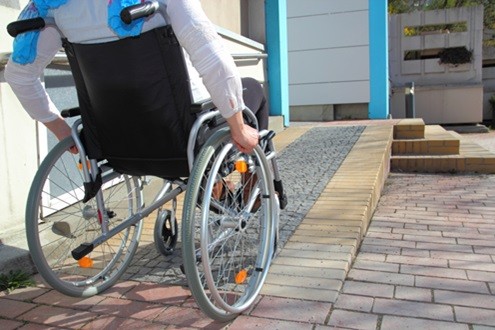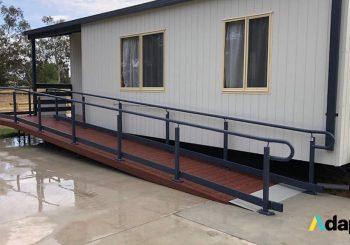Wheelchair ramp safety isn’t something you can take lightly.
The risk of slippage while moving on a disability ramp can be very high if you haven’t taken the right precautions. Rain during summertime can make movement on wheelchair ramps slippery and difficult.
The best way to ensure that the disability ramp on your property is safe for use, is to install a slip-resistant surface on it. Here we will look at the different types of ramp materials and which would need slip-resistant features installed.
Types of Ramp Materials that require slip-resistant features
#1 Wood
This is one of the most popular wheelchair ramp-construction material. It needs specialised installation, is moderately slip-resistant, and is a permanent feature. When you opt for good quality hardwood and maintain the feature well it can last for between 15 and 20 years.
Wood is a high-maintenance material that can benefit from a slip-resistant surface. You have the option to install rubber strips or apply slip-resistant textured paint on the surface. There are a number of different slip-resistant products to choose from and these offer good traction.
Rubber tiles and rubber matting are other options to create a slip-resistant surface. FRP mini-mesh grating can also be used to increase traction on ramps. However, this material is generally installed in commercial and industrial settings rather than residential ones.
#2 Metal
Metal ramps are durable and low maintenance, bur require anti-rust treatments. While some wooden ramps may have metal sheets installed on them, other features may be made entirely of metal. It’s important to ensure there aren’t any large gaps in the metal surface sheets as crutches and canes can become stuck in them. The surfaces would need some anti-slip rubber strips to prevent slippage.
#3 Aluminium
These modular ramps are extremely resilient and durable and are semi-permanent features that won’t rust in the manner that other metals will. Since they are made of multiple sections, you have the flexibility to dismantle and install them in some other location if required. These ramps offer a good amount of traction but you can always install rubber strips for added slip-resistance.
#4 Cement
This is another material popularly used in ramp installations. These structures are permanent and need a very solid base and foundation to stand on. Well-constructed concrete ramps can last for a very long time if maintained well. However, concrete surfaces, even ones that have some texture, tend to become slippery in the rains.
Poor maintenance can cause cracks or chipping in the cement. Installing rubber paving on cement ramps can make the surfaces slip-resistant and help cover minor damages as well. You can also install rubber strips along the entire length of the ramp to make the surface safer for wheelchair users.
Opt For Durable And Resilient Adapta Disability Ramps
We at Adapta are the wheelchair ramp specialists and cater to residential as well as commercial clients. We can provide you detailed information about the different types of ramps we offer, the specifications, layouts etc. Our ramps are available in a variety of layouts and are suitable for different types of settings. The information we provide can help you make a better-informed decision about the type of ramp you want for your property.
Based on your setting, requirement, preferences, and budget you can choose the type of disability ramps style, layout etc. We provide a wide variety of ramp layouts and options. You can call 1800 232 782 or contact Adapta through this form and one of our representatives will contact you shortly. They will have detailed discussions with you, to understand your needs, before recommending a good solution.



